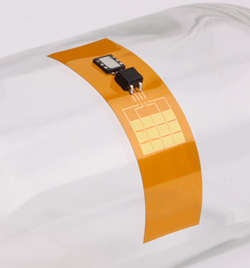Beating Heart Powers Pacemaker
New biomedical device converts heart’s mechanical energy to electrical energy
An interdisciplinary research team including Northwestern University’s Yonggang Huang has developed a flexible medical implant that harvests the energy of the beating heart. Such a device could power pacemakers, defibrillators and heart-rate monitors naturally and reliably and reduce or eliminate the need for batteries.
Huang and his longtime collaborator John A. Rogers of the University of Illinois worked with cardiologists at the University of Arizona. The interdisciplinary team developed and demonstrated a device that converts the mechanical energy from the natural motions of the heart, lung and diaphragm into electrical energy -- enough to easily charge a pacemaker or battery for other practical uses.
 The study was published last month in print by the journal PNAS.
The study was published last month in print by the journal PNAS.
“Unlike our earlier stretchable electronics work, this time we wanted strain in our piezoelectric material for the mechanical energy it produces, and our challenge was that we had to control that strain very precisely,” said Huang, who led the portion of the research focused on theory, design and modeling. Piezoelectric means a voltage develops across the material when it is pressed or bent.
“We carefully designed the device so the piezoelectric material would be pushed to nearly the breaking point, where we could capture the maximum amount of energy,” he said. “Once this kind of energy is harvested, it can charge a lot of different implantable devices.”
Huang is the Joseph Cummings Professor of Civil and Environmental Engineering and Mechanical Engineering at Northwestern’s McCormick School of Engineering and Applied Science.
“I think the concept of creating electrical power from motions in internal organs is really interesting,” Rogers told the magazine New Scientist. “The key thing is, if you’re going to do this, you need to be able to achieve efficiency and ultimately power output that is of practical use.”
Rogers, the paper’s corresponding author, led the group that worked on the experimental and fabrication work of the implantable device. He is the Swanlund Chair at the University of Illinois at Urbana-Champaign.
 The piezoelectric material Huang and Rogers used was encapsulated lead zirconate titanate (PZT), a ceramic commonly used for sensors but not often used in biomedical devices. When you press the material, it generates an electrical signal. The mechanical beating of the heart or the motion of the diaphragm from breathing does the pressing.
The piezoelectric material Huang and Rogers used was encapsulated lead zirconate titanate (PZT), a ceramic commonly used for sensors but not often used in biomedical devices. When you press the material, it generates an electrical signal. The mechanical beating of the heart or the motion of the diaphragm from breathing does the pressing.
Thin ribbons of PZT are surrounded by flexible, biocompatible plastic, with a rechargeable battery and an electrical device called a rectifier integrated into the system. The entire package is approximately 2.2 centimeters by 2.5 centimeters.
Huang and Rogers worked closely with Marvin H. Slepian, a cardiologist at the University of Arizona, and his colleagues, who conducted the animal studies. The device was attached to the hearts, lungs and diaphragms of living animal models, and the mechanical motion of the internal organs produced enough energy to charge a 3.8-volt battery.
“This work is a great demonstration of engineers working with doctors and taking advantage of the natural properties of a beating heart,” Huang said. “We envision this device being used to power a pacemaker with the energy coming right from the heart.”
Huang and his Northwestern team developed theoretical models that establish design rules and capture key behaviors of the device. They will optimize different design layouts of the stretchable mechanical energy harvester to facilitate its easy use on animal models.
The U.S. Department of Energy, Office of Basic Energy Sciences (Award DE-FG02-07ER4647) and the Institute for Sustainability and Energy at Northwestern University (ISEN) supported the research.
The paper is titled “Conformal piezoelectric energy harvesting and storage from motions of the heart, lung, and diaphragm.”